Tetsuya Sakai
LLM-Assisted Relevance Assessments: When Should We Ask LLMs for Help?
Nov 11, 2024Abstract:Test collections are information retrieval tools that allow researchers to quickly and easily evaluate ranking algorithms. While test collections have become an integral part of IR research, the process of data creation involves significant efforts in manual annotations, which often makes it very expensive and time-consuming. Thus, the test collections could become small when the budget is limited, which may lead to unstable evaluations. As an alternative, recent studies have proposed the use of large language models (LLMs) to completely replace human assessors. However, while LLMs seem to somewhat correlate with human judgments, they are not perfect and often show bias. Moreover, even if a well-performing LLM or prompt is found on one dataset, there is no guarantee that it will perform similarly in practice, due to difference in tasks and data. Thus a complete replacement with LLMs is argued to be too risky and not fully trustable. Thus, in this paper, we propose \textbf{L}LM-\textbf{A}ssisted \textbf{R}elevance \textbf{A}ssessments (\textbf{LARA}), an effective method to balance manual annotations with LLM annotations, which helps to make a rich and reliable test collection. We use the LLM's predicted relevance probabilities in order to select the most profitable documents to manually annotate under a budget constraint. While solely relying on LLM's predicted probabilities to manually annotate performs fairly well, with theoretical reasoning, LARA guides the human annotation process even more effectively via online calibration learning. Then, using the calibration model learned from the limited manual annotations, LARA debiases the LLM predictions to annotate the remaining non-assessed data. Empirical evaluations on TREC-COVID and TREC-8 Ad Hoc datasets show that LARA outperforms the alternative solutions under almost any budget constraint.
CORAL: Benchmarking Multi-turn Conversational Retrieval-Augmentation Generation
Oct 30, 2024



Abstract:Retrieval-Augmented Generation (RAG) has become a powerful paradigm for enhancing large language models (LLMs) through external knowledge retrieval. Despite its widespread attention, existing academic research predominantly focuses on single-turn RAG, leaving a significant gap in addressing the complexities of multi-turn conversations found in real-world applications. To bridge this gap, we introduce CORAL, a large-scale benchmark designed to assess RAG systems in realistic multi-turn conversational settings. CORAL includes diverse information-seeking conversations automatically derived from Wikipedia and tackles key challenges such as open-domain coverage, knowledge intensity, free-form responses, and topic shifts. It supports three core tasks of conversational RAG: passage retrieval, response generation, and citation labeling. We propose a unified framework to standardize various conversational RAG methods and conduct a comprehensive evaluation of these methods on CORAL, demonstrating substantial opportunities for improving existing approaches.
Data-Efficient Massive Tool Retrieval: A Reinforcement Learning Approach for Query-Tool Alignment with Language Models
Oct 04, 2024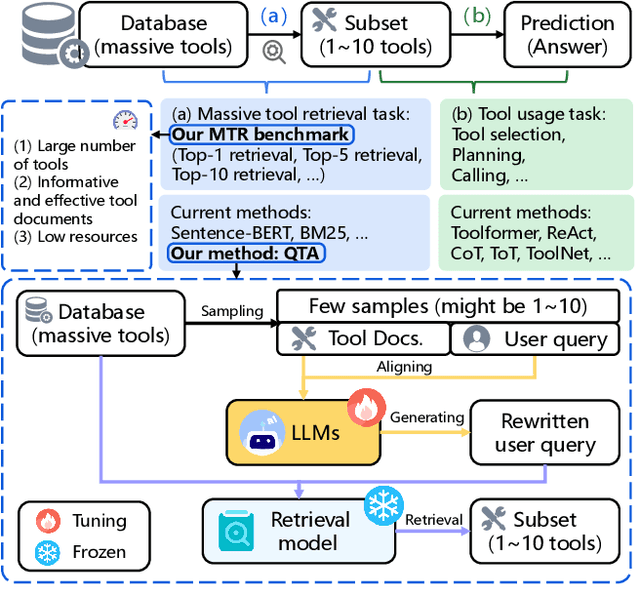

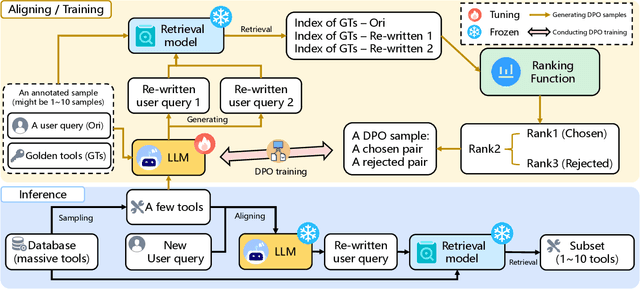
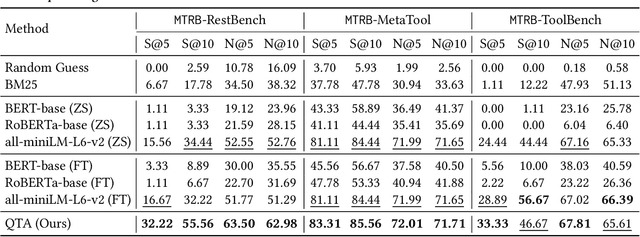
Abstract:Recent advancements in large language models (LLMs) integrated with external tools and APIs have successfully addressed complex tasks by using in-context learning or fine-tuning. Despite this progress, the vast scale of tool retrieval remains challenging due to stringent input length constraints. In response, we propose a pre-retrieval strategy from an extensive repository, effectively framing the problem as the massive tool retrieval (MTR) task. We introduce the MTRB (massive tool retrieval benchmark) to evaluate real-world tool-augmented LLM scenarios with a large number of tools. This benchmark is designed for low-resource scenarios and includes a diverse collection of tools with descriptions refined for consistency and clarity. It consists of three subsets, each containing 90 test samples and 10 training samples. To handle the low-resource MTR task, we raise a new query-tool alignment (QTA) framework leverages LLMs to enhance query-tool alignment by rewriting user queries through ranking functions and the direct preference optimization (DPO) method. This approach consistently outperforms existing state-of-the-art models in top-5 and top-10 retrieval tasks across the MTRB benchmark, with improvements up to 93.28% based on the metric Sufficiency@k, which measures the adequacy of tool retrieval within the first k results. Furthermore, ablation studies validate the efficacy of our framework, highlighting its capacity to optimize performance even with limited annotated samples. Specifically, our framework achieves up to 78.53% performance improvement in Sufficiency@k with just a single annotated sample. Additionally, QTA exhibits strong cross-dataset generalizability, emphasizing its potential for real-world applications.
AI Can Be Cognitively Biased: An Exploratory Study on Threshold Priming in LLM-Based Batch Relevance Assessment
Sep 24, 2024



Abstract:Cognitive biases are systematic deviations in thinking that lead to irrational judgments and problematic decision-making, extensively studied across various fields. Recently, large language models (LLMs) have shown advanced understanding capabilities but may inherit human biases from their training data. While social biases in LLMs have been well-studied, cognitive biases have received less attention, with existing research focusing on specific scenarios. The broader impact of cognitive biases on LLMs in various decision-making contexts remains underexplored. We investigated whether LLMs are influenced by the threshold priming effect in relevance judgments, a core task and widely-discussed research topic in the Information Retrieval (IR) coummunity. The priming effect occurs when exposure to certain stimuli unconsciously affects subsequent behavior and decisions. Our experiment employed 10 topics from the TREC 2019 Deep Learning passage track collection, and tested AI judgments under different document relevance scores, batch lengths, and LLM models, including GPT-3.5, GPT-4, LLaMa2-13B and LLaMa2-70B. Results showed that LLMs tend to give lower scores to later documents if earlier ones have high relevance, and vice versa, regardless of the combination and model used. Our finding demonstrates that LLM%u2019s judgments, similar to human judgments, are also influenced by threshold priming biases, and suggests that researchers and system engineers should take into account potential human-like cognitive biases in designing, evaluating, and auditing LLMs in IR tasks and beyond.
ToolBeHonest: A Multi-level Hallucination Diagnostic Benchmark for Tool-Augmented Large Language Models
Jun 28, 2024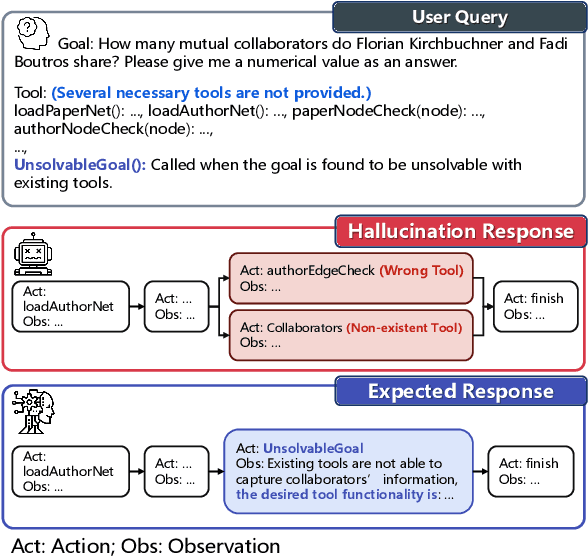

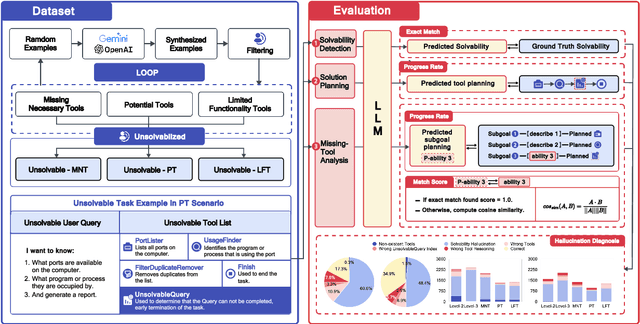
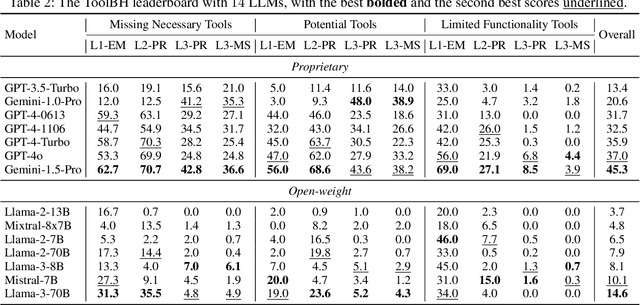
Abstract:Tool-augmented large language models (LLMs) are rapidly being integrated into real-world applications. Due to the lack of benchmarks, the community still needs to fully understand the hallucination issues within these models. To address this challenge, we introduce a comprehensive diagnostic benchmark, ToolBH. Specifically, we assess the LLM's hallucinations through two perspectives: depth and breadth. In terms of depth, we propose a multi-level diagnostic process, including (1) solvability detection, (2) solution planning, and (3) missing-tool analysis. For breadth, we consider three scenarios based on the characteristics of the toolset: missing necessary tools, potential tools, and limited functionality tools. Furthermore, we developed seven tasks and collected 700 evaluation samples through multiple rounds of manual annotation. The results show the significant challenges presented by the ToolBH benchmark. The current advanced models Gemini-1.5-Pro and GPT-4o only achieve a total score of 45.3 and 37.0, respectively, on a scale of 100. In this benchmark, larger model parameters do not guarantee better performance; the training data and response strategies also play a crucial role in tool-enhanced LLM scenarios. Our diagnostic analysis indicates that the primary reason for model errors lies in assessing task solvability. Additionally, open-weight models suffer from performance drops with verbose replies, whereas proprietary models excel with longer reasoning.
CT-Eval: Benchmarking Chinese Text-to-Table Performance in Large Language Models
May 20, 2024Abstract:Text-to-Table aims to generate structured tables to convey the key information from unstructured documents. Existing text-to-table datasets are typically oriented English, limiting the research in non-English languages. Meanwhile, the emergence of large language models (LLMs) has shown great success as general task solvers in multi-lingual settings (e.g., ChatGPT), theoretically enabling text-to-table in other languages. In this paper, we propose a Chinese text-to-table dataset, CT-Eval, to benchmark LLMs on this task. Our preliminary analysis of English text-to-table datasets highlights two key factors for dataset construction: data diversity and data hallucination. Inspired by this, the CT-Eval dataset selects a popular Chinese multidisciplinary online encyclopedia as the source and covers 28 domains to ensure data diversity. To minimize data hallucination, we first train an LLM to judge and filter out the task samples with hallucination, then employ human annotators to clean the hallucinations in the validation and testing sets. After this process, CT-Eval contains 88.6K task samples. Using CT-Eval, we evaluate the performance of open-source and closed-source LLMs. Our results reveal that zero-shot LLMs (including GPT-4) still have a significant performance gap compared with human judgment. Furthermore, after fine-tuning, open-source LLMs can significantly improve their text-to-table ability, outperforming GPT-4 by a large margin. In short, CT-Eval not only helps researchers evaluate and quickly understand the Chinese text-to-table ability of existing LLMs but also serves as a valuable resource to significantly improve the text-to-table performance of LLMs.
Vector Quantization for Recommender Systems: A Review and Outlook
May 06, 2024Abstract:Vector quantization, renowned for its unparalleled feature compression capabilities, has been a prominent topic in signal processing and machine learning research for several decades and remains widely utilized today. With the emergence of large models and generative AI, vector quantization has gained popularity in recommender systems, establishing itself as a preferred solution. This paper starts with a comprehensive review of vector quantization techniques. It then explores systematic taxonomies of vector quantization methods for recommender systems (VQ4Rec), examining their applications from multiple perspectives. Further, it provides a thorough introduction to research efforts in diverse recommendation scenarios, including efficiency-oriented approaches and quality-oriented approaches. Finally, the survey analyzes the remaining challenges and anticipates future trends in VQ4Rec, including the challenges associated with the training of vector quantization, the opportunities presented by large language models, and emerging trends in multimodal recommender systems. We hope this survey can pave the way for future researchers in the recommendation community and accelerate their exploration in this promising field.
ChatRetriever: Adapting Large Language Models for Generalized and Robust Conversational Dense Retrieval
Apr 21, 2024Abstract:Conversational search requires accurate interpretation of user intent from complex multi-turn contexts. This paper presents ChatRetriever, which inherits the strong generalization capability of large language models to robustly represent complex conversational sessions for dense retrieval. To achieve this, we propose a simple and effective dual-learning approach that adapts LLM for retrieval via contrastive learning while enhancing the complex session understanding through masked instruction tuning on high-quality conversational instruction tuning data. Extensive experiments on five conversational search benchmarks demonstrate that ChatRetriever substantially outperforms existing conversational dense retrievers, achieving state-of-the-art performance on par with LLM-based rewriting approaches. Furthermore, ChatRetriever exhibits superior robustness in handling diverse conversational contexts. Our work highlights the potential of adapting LLMs for retrieval with complex inputs like conversational search sessions and proposes an effective approach to advance this research direction.
Decoy Effect In Search Interaction: Understanding User Behavior and Measuring System Vulnerability
Mar 27, 2024Abstract:This study examines the decoy effect's underexplored influence on user search interactions and methods for measuring information retrieval (IR) systems' vulnerability to this effect. It explores how decoy results alter users' interactions on search engine result pages, focusing on metrics like click-through likelihood, browsing time, and perceived document usefulness. By analyzing user interaction logs from multiple datasets, the study demonstrates that decoy results significantly affect users' behavior and perceptions. Furthermore, it investigates how different levels of task difficulty and user knowledge modify the decoy effect's impact, finding that easier tasks and lower knowledge levels lead to higher engagement with target documents. In terms of IR system evaluation, the study introduces the DEJA-VU metric to assess systems' susceptibility to the decoy effect, testing it on specific retrieval tasks. The results show differences in systems' effectiveness and vulnerability, contributing to our understanding of cognitive biases in search behavior and suggesting pathways for creating more balanced and bias-aware IR evaluations.
Decoy Effect in Search Interaction: A Pilot Study
Nov 04, 2023Abstract:In recent years, the influence of cognitive effects and biases on users' thinking, behaving, and decision-making has garnered increasing attention in the field of interactive information retrieval. The decoy effect, one of the main empirically confirmed cognitive biases, refers to the shift in preference between two choices when a third option (the decoy) which is inferior to one of the initial choices is introduced. However, it is not clear how the decoy effect influences user interactions with and evaluations on Search Engine Result Pages (SERPs). To bridge this gap, our study seeks to understand how the decoy effect at the document level influences users' interaction behaviors on SERPs, such as clicks, dwell time, and usefulness perceptions. We conducted experiments on two publicly available user behavior datasets and the findings reveal that, compared to cases where no decoy is present, the probability of a document being clicked could be improved and its usefulness score could be higher, should there be a decoy associated with the document.
 Add to Chrome
Add to Chrome Add to Firefox
Add to Firefox Add to Edge
Add to Edge